
JOURNAL OF THERMAL SPRAY TECHNOLOGY
Scope & Guideline
Pioneering Insights into Thermal Spray Processes and Materials
Introduction
Aims and Scopes
- Thermal Spray Processes and Techniques:
The journal covers a range of thermal spray processes including High-Velocity Oxy-Fuel (HVOF), Plasma Spraying, Cold Spray, and Detonation Spraying, focusing on the operational parameters and their effects on coating properties. - Material Development and Characterization:
Research on the development of new materials, particularly high-entropy alloys, composite coatings, and advanced ceramics, is a core focus, along with their characterization for mechanical, thermal, and corrosion resistance. - Application in Industry:
The journal emphasizes applications of thermal spray technologies in various fields such as aerospace, biomedical, energy, and automotive sectors, highlighting innovations that enhance performance and durability. - Simulation and Modeling:
Numerical modeling and simulation studies are frequently published, addressing the physics of the thermal spray process, particle dynamics, and thermal behavior, contributing to the optimization of coating processes. - Surface Engineering and Coating Performance:
The performance of thermal spray coatings is a significant theme, including studies on wear resistance, corrosion resistance, and tribological behavior, as well as surface modifications to enhance functionality.
Trending and Emerging
- High-Entropy Alloy Coatings:
Research on high-entropy alloy coatings is on the rise, highlighting their superior properties and potential applications in extreme environments, such as aerospace and energy sectors. - Machine Learning and AI Integration:
The integration of machine learning and artificial intelligence in optimizing thermal spray processes and predicting coating properties is becoming a significant trend, enhancing efficiency and precision. - Environmental and Sustainable Coatings:
There is an increasing focus on developing environmentally friendly and sustainable thermal spray coatings, including biocidal and antifouling applications, addressing global sustainability challenges. - Advanced Characterization Techniques:
The use of advanced characterization techniques such as in situ monitoring, acoustic emission, and high-speed imaging is trending, providing deeper insights into coating formation and performance. - Multifunctional Coatings:
Research into multifunctional coatings that combine properties such as wear resistance, thermal insulation, and antimicrobial effects is gaining prominence, reflecting the demand for versatile materials in various applications.
Declining or Waning
- Basic Research on Conventional Coatings:
There has been a noticeable decline in papers focusing solely on basic studies of conventional thermal spray coatings, as the field shifts towards more advanced materials and innovative applications. - Non-Interdisciplinary Approaches:
Papers that do not incorporate interdisciplinary methodologies or applications are becoming less common, as there is a growing emphasis on combining thermal spray technology with other fields such as biotechnology and nanotechnology. - Traditional Surface Treatments:
Research on traditional surface treatments and coatings that do not utilize advanced thermal spray methods is declining, indicating a shift towards more modern, innovative processes.
Similar Journals

Tungsten
Exploring the essential role of tungsten in materials science.Tungsten, published by SpringerNature, is a prestigious academic journal dedicated to advancing the field of materials science with a specific focus on tungsten and its diverse applications. Launched in 2019, the journal has quickly established itself as a leading resource in its domain, achieving a remarkable Q1 ranking across multiple categories including Materials Chemistry, Materials Science (miscellaneous), Metals and Alloys, and Surfaces, Coatings and Films. With robust performance reflected in its Scopus rankings—holding significant positions such as rank #20 in Metals and Alloys (88th percentile)—Tungsten serves as a vital platform for researchers and professionals seeking to disseminate innovative findings and foster collaboration in the materials science community. Although not an Open Access publication, this journal offers a well-curated collection of high-quality research articles, reviews, and technical notes aimed at driving forward the understanding and application of tungsten in various scientific sectors. Operating out of the United States, Tungsten is committed to providing an essential resource for academia and industry alike, making a significant contribution to the evolving landscape of materials research.
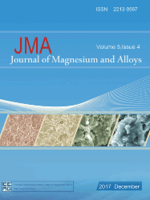
Journal of Magnesium and Alloys
Exploring Innovations in Magnesium and AlloysThe Journal of Magnesium and Alloys is a prestigious, peer-reviewed academic publication dedicated to advancing the field of materials science, particularly focusing on magnesium and its alloys. Published by KEAI PUBLISHING LTD since 2013, this Open Access journal enables unrestricted dissemination of research findings, enhancing global collaboration among researchers, professionals, and students. With an ISSN of 2213-9567 and a significant impact factor, it has established itself in the upper quartiles (Q1) of both the Mechanics of Materials and Metals and Alloys categories, ranking #3 out of 176 and #9 out of 398 respectively according to Scopus. The journal aims to provide a forum for the latest advances in the understanding, production, and application of magnesium alloys, fostering innovation and sustainable practices within the materials engineering community. Based in Beijing, China, the journal is committed to bridging gaps in current knowledge and driving future research directions through its high-quality publications.
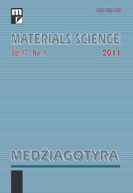
Materials Science-Medziagotyra
Innovating Tomorrow's Materials TodayMaterials Science-Medziagotyra is a prominent peer-reviewed journal dedicated to the field of materials science, published by Kaunas University of Technology in Lithuania. Since its transition to an Open Access model in 2012, it has facilitated broad dissemination of research findings, enhancing accessibility for researchers and professionals worldwide. This journal is indexed in Scopus and has consistently contributed to the academic community with a focus on innovative materials and their applications, ranking in the Q3 category of Materials Science (miscellaneous) as of 2023. With the responsibility of synthesizing substantial research from 2008 through 2024, Materials Science-Medziagotyra aims to bridge gaps in material research while fostering collaboration among scientists, students, and industry leaders. Its commitment to quality and rigor in scientific discourse underscores its relevance and importance in advancing the field.

ATOMIZATION AND SPRAYS
Innovating the Future of Spray TechnologiesATOMIZATION AND SPRAYS, published by BEGELL HOUSE INC, stands at the forefront of research in the dynamic field of chemical engineering, particularly focusing on the intricate processes of atomization and the mechanics of droplet dynamics. Established in 1996, this prestigious journal aims to disseminate innovative findings and methodologies that drive advancements in applications ranging from spray technologies in industrial processes to environmental technology and energy conversion systems. With a current Impact Factor that reflects its significance within the community—ranked in the Q3 quartile—it serves as a comprehensive resource for researchers, professionals, and students eager to deepen their understanding of fluid mechanics and spray applications. Though not an open-access publication, it provides critical insights and a platform for scholarly communication and exchange in its converged years, fostering collaboration and innovation within the domain.

Advances in Materials Research-An International Journal
Transforming Ideas into Material SolutionsAdvances in Materials Research - An International Journal is an esteemed publication in the field of materials science, spearheaded by TECHNO-PRESS. Established to provide a critical platform for the dissemination of high-quality research, this journal focuses on a broad spectrum of topics, including Biomaterials, Ceramics, Composites, Electronic, Optical, Magnetic Materials, Metals, Alloys, and Polymers. With a commendable impact factor reflecting its substantial contribution to the scientific community, Advances in Materials Research promotes innovative ideas through rigorous peer-review processes and supports the continuous advancement of materials research, particularly in the dynamic environment of South Korea. This journal, which holds impressive rankings across various subfields in the Scopus database, is designed to cater to the needs of researchers, professionals, and students aiming to stay at the cutting edge of materials science. By bridging gaps between theory and application, it invites contributions that push the boundaries of knowledge and technology in diverse material applications.

China Surface Engineering
Shaping the future of surface technology.China Surface Engineering is a prominent academic journal dedicated to the field of materials science, with a specific emphasis on surfaces, coatings, and films. Published by the Chinese Association of Science and Technology (CAST), this journal serves as an essential platform for researchers, professionals, and students seeking to disseminate knowledge and advancements in surface engineering technologies and innovative applications. With its ISSN 1007-9289 and E-ISSN 1007-9289, it has established a distinct presence since its convergence in 2016, and continues to evolve in the rapidly advancing materials science landscape through to 2024. Although currently categorized in the Q4 quartile of its field, with a Scopus ranking of #103 out of 132 in Surfaces, Coatings and Films, the journal plays a critical role in contributing to the discourse surrounding surface treatment and modification, fostering advancements that are pivotal for industrial applications. As an avenue not only for knowledge transfer but also for collaboration among scientists worldwide, China Surface Engineering is crucial for anyone engaged in research or practical applications in this domain.
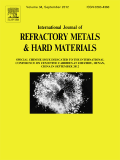
INTERNATIONAL JOURNAL OF REFRACTORY METALS & HARD MATERIALS
Advancing the frontiers of materials science.INTERNATIONAL JOURNAL OF REFRACTORY METALS & HARD MATERIALS, an esteemed publication by Elsevier Science Ltd, stands at the forefront of materials research, focusing on the development and application of refractory metals and hard materials in various engineering fields. With an impressive impact factor and recognition as a Q1 journal across several categories including Ceramics and Composites, Materials Chemistry, and Mechanical Engineering, it serves as a vital resource for researchers, professionals, and students alike. The journal has been continuously publishing high-quality research since its inception in 1982, with a convergence of developments spanning through to 2024. Its Scopus rankings further emphasize its significance, boasting ranks in the top percentiles of relevant scientific fields. Although it operates under a subscription model, the depth and rigor of the research published within its pages ensures that it remains an invaluable tool for those pursuing innovation and exploration in materials science.
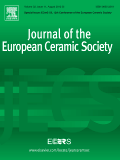
Journal of the European Ceramic Society
Connecting Ideas in Ceramics and Materials ChemistryThe Journal of the European Ceramic Society, published by Elsevier, is a premier academic periodical dedicated to the cutting-edge advancements in the fields of ceramics and composites, as well as materials chemistry. With an impressive impact factor that places it in the top quartile (Q1) of its category, it ranks #33 out of 317 in Materials Science and #16 out of 127 in Ceramics and Composites, showcasing its strong influence in the scientific community. Established in 1989 and set to converge until 2025, this journal serves as a critical platform for researchers and professionals to disseminate their findings, share ideas, and foster collaboration in the rapidly evolving area of ceramic materials. Although it does not offer Open Access options, the journal ensures rigorous peer review and maintains high standards for publication, making it an essential resource for students, academics, and industry experts who are pushing the boundaries of material science.
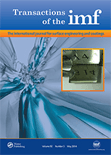
TRANSACTIONS OF THE INSTITUTE OF METAL FINISHING
Advancing Knowledge in Surface Engineering and Materials ScienceTRANSACTIONS OF THE INSTITUTE OF METAL FINISHING, published by Taylor & Francis Ltd, is a premier journal dedicated to the field of metal finishing and surface engineering. With an ISSN of 0020-2967 and E-ISSN of 1745-9192, this journal has been a critical resource for researchers and practitioners since its inception in 1969. Covering a broad scope that includes condensed matter physics, mechanics of materials, and the intricate science of metals and alloys, TRANSACTIONS OF THE INSTITUTE OF METAL FINISHING has established itself within the academic community, currently holding Q2 and Q3 rankings across multiple relevant categories in 2023. While not openly accessible, the journal remains a vital compendium of innovative research findings and advancements, attracting contributors and readers eager to explore cutting-edge developments in metal finishing techniques and applications. The insightful articles published here cater to a wide audience, including industry professionals, academic researchers, and students, who seek to improve their understanding of materials science and engineering practices.
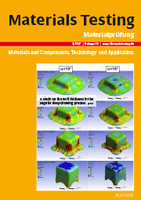
Materials Testing
Empowering Research in Mechanics of MaterialsMaterials Testing is a renowned journal published by Walter de Gruyter GmbH, serving the global scientific community in the fields of Materials Science, Mechanical Engineering, and Mechanics of Materials. With an ISSN of 0025-5300 and an E-ISSN of 2195-8572, this journal has been a significant contributor to the discourse on material performance, testing methodologies, and engineering innovations since its inception. The journal is recognized for its rigorous peer-review process and holds a commendable Q2 quartile ranking in multiple categories for 2023, showcasing its impact and relevance in the field. With open access options available, Materials Testing aims to disseminate valuable research findings and practical insights that drive advancements in technology and materials applications. By addressing the latest challenges and developments within the field, this publication serves as an essential resource for researchers, professionals, and students alike, fostering a deeper understanding of material properties and testing techniques.